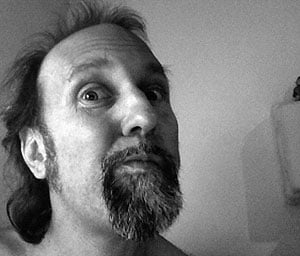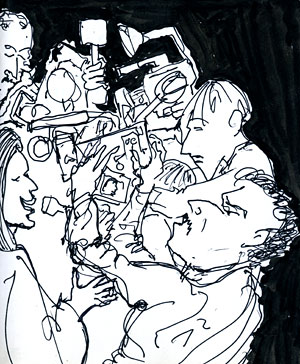
George Michelsen Foy’s article “Bollywood Shuffle” appears in the October Harper’s Magazine. Associate Editor Benjamin Austen catches up with Foy now that the issue is on newsstands.
1. “Bollywood Shuffle” chronicles your efforts—as a white Westerner—to land a role in a Bollywood film. With few prospects, you travel to Bombay and begin this quixotic quest. What advice can you give other would-be actors not of Indian ancestry who have caught the movie bug and want to be in a Bollywood film?
I’d say the first thing to do is meet people, which is easier than it sounds. Bollywood is huge as an industry, but at least in the Hindi film segment everybody basically knows everybody else. As my article shows, even pretty big names are accessible. And people generally are friendlier and more willing to help than in Los Angeles. So if you know anyone in any way hooked up to Bollywood, call that person. He (or she) will usually welcome the interest. And once you get to the director/producer level, you’ll find that the movers and shakers are often as anxious to score contacts in Hollywood and the U.S. film industry as you are to get contacts in the Indian version. (Hollywood and the American movie-going public—not to mention the growing Indian population in North America—are the new frontier in Indian film marketing.)
You should also do your homework: see some recent Bollywood films so you know the top directors, actors, and songwriters by name and appearance. Check out websites like Bollywoodworld.com and Masala.com for the latest gossip about who’s planning what film with which talent. If a film looks like it will include topics or locations that might involve Western characters, write down the names of the casting agents, directors, producers. Ask your contacts if they know any of these people.
If you can’t find anyone Bollywood-connected while you’re in the United States, you can always fly to Bombay and stay at a hotel in or near Colaba—the center of the old colonial city, where Westerners, apparently nostalgic for the Raj, tend to group. The Colaba area is full of touts who are on the lookout for whites to act as extras when a shoot calls for them. The best places to meet these agents around the Colaba Causeway (the main drag) seem to be Cafe Leopold, the Regal Cinema, the Salvation Army hostel, and the lobby of the President Hotel. Ask around. Hang out. Buy drinks for the touts. And don’t forget to bring headshots and business cards. Touts, casting agents, and directors will all ask for them.
Another, more expensive option for making your face known is to go to clubs and “lounges,” especially in Juhu Beach and Versova. The bars and clubs of the Holiday Inn (oddly enough) and the JW Marriott at Juhu are big Bollywood hangouts, or were when I was there. The best parties in these areas are usually tied to movie premieres or releases of film soundtracks or albums by Bollywood stars. In Juhu, I’ve run across people like Shahrukh Khan and Abhishek Bachchan—escorted by their crowd and bodyguards. The bars and the nightclub at the Taj, in Colaba, attract the Bollywood jetsetters, but given how expensive the Taj is, I’m not sure the cost/benefit ratio of hanging out there is worth it. Still, after only a short time in Bombay, I started to recognize the faces of directors and producers and their friends at these parties. Even if this doesn’t lead to a part in a film, with luck you can at least get invited to better and better parties.

2. I’m interested to hear more about these Bollywood parties. Were they very different from how we imagine a party in Santa Monica of Hollywood insiders? Do you feel you learned anything about how Bollywood sees itself from these celebrations of itself?
As with Hollywood, Bollywood is full of rumors of its elite being involved in drugs, promiscuous sex, and other decadence. The press that covers the industry is still surprisingly coy about such behavior, yet I sensed that there was truth to at least some of these stories. People I trust told me about parties they had attended where they witnessed the debauchery firsthand. I never got that lucky. The last party I went to looked like it was heading in that direction. It was for a charity I can’t remember, at a club on the harbor at Colaba, right next to a shantytown occupied mainly by the Coli, the tribe of fisherfolk who were the original inhabitants of the Bombay area. There were a bunch of mid-to-upper-level Bollywood people there, as well as many jeunesse dorée–publishing scions and the like.
The party was open bar, and the club was set up as an archipelago of islands and walkways dotting a shallow, black reflecting pool filled with floating candles and flowers. Hordes of pretty girls and boys sashayed up and down the walkways; they even had a competition for the best-looking model. I ran into several people I knew, including a gorgeous would-be actress who had gone to school in Belgium and spoke good French. The party was moving on to after-hours events, and the Belgian-Indian told me to tag along. But I’d probably had one or two too many drinks, and I found myself thinking about the shantytown next door, and the people sleeping in the streets not fifty yards away, bundled up on the tarmac, with rats patrolling. I know it’s the classic, guilt-ridden reflex of the Westerner (and probably there was some jealousy in there too, stemming from not being young and gorgeous), but I couldn’t help myself. I ended up dragging an Indian friend out the doors and through the shantytown, as if I had the right to make a moral point with him, given the disparity of riches in my own country. He got mad at me, and rightly so.
3. While you were in Bombay, did you get a sense of the lifestyles of Bollywood’s popular actors? I’ve heard a good deal about the many obligations they have to do commercials and other public-relations work. Did you see any of this firsthand?
The closest I got to Bollywood’s top stars was actually at a publicity event for De Beers, the diamond cartel. De Beers had hired Amitabh Bachchan—the most famous male actor in India, something like George Clooney and Paul Newman rolled into one—to promote its wares. I can only guess at what Bachchan earned, on top of the specially engraved “forevermark” diamond that De Beers gave him with great ceremony. It was incredible: more than one hundred photographers and reporters and cameramen all focused on him and anything he touched. So I guess it was worth it for De Beers, whatever they paid. The company had also hired Tom Alter, the top white actor in India, whom I interview in my article, to be the master of ceremonies. The event was at the Taj Land’s End in Bandra, in the northern suburbs, also on the waterfront—right across the road from the Sea Rock, which was bombed by Muslim extremists a few years ago. There was a buffet seventy-five feet long, with Chinese, Indian and Western food, Moët, vodka bottles encased in ice, and an Austrian laser-light show. As pitchmen, both Alter and Bachchan did their jobs like real professionals. Alter intoned the pitiful PR lines as if they were Hamlet. He told me later that he could spend months working on a fantastic film and make less money than he did in one evening playing this kind of gig.


